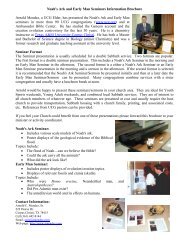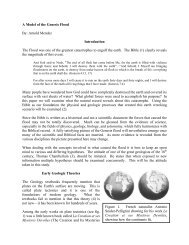Wickedness of the Pre-flood World - Noah's Ark & Early Man Seminars
Wickedness of the Pre-flood World - Noah's Ark & Early Man Seminars
Wickedness of the Pre-flood World - Noah's Ark & Early Man Seminars
- No tags were found...
Create successful ePaper yourself
Turn your PDF publications into a flip-book with our unique Google optimized e-Paper software.
Mendez 2O<strong>the</strong>r anthropologists looked at <strong>the</strong> evidence in a totally different light and came up withdiffering conclusions. They saw <strong>the</strong> fossil evidence supporting burial practices. In <strong>the</strong>se burialpractices, <strong>the</strong> body would be defleshed and <strong>the</strong>n buried. In some supposed cases, where <strong>the</strong>braincases were shattered <strong>the</strong> brains were supposedly extracted and separately buried. Thisevidence has been hotly debated in evolutionary circles.The question <strong>of</strong> cannibalism and <strong>the</strong> dismemberment <strong>of</strong> <strong>the</strong> corpses <strong>of</strong> <strong>the</strong> Krapina People has beensuggested on <strong>the</strong> grounds <strong>of</strong> fragmentation, cut marks and bone splitting. This has been discounted byTrinkaus on <strong>the</strong> basis that <strong>the</strong>re is no evidence <strong>of</strong> damage that cannot be explained in o<strong>the</strong>r way thancannibalism (2).The anthropological community is slowly realizing that <strong>the</strong> fossil evidence overwhelminglysupports <strong>the</strong> view that many Neanderthals were cannibalistic and that <strong>the</strong> evidence does notsupport supposed mortuary practices.After 30 years <strong>of</strong> research, Turner says it is a modern bias to insist that cannibalism isn't part <strong>of</strong> humannature. <strong>Man</strong>y o<strong>the</strong>r species eat <strong>the</strong>ir own, and our ancestors may have had <strong>the</strong>ir own "good" reasons—whe<strong>the</strong>r to terrorize subject peoples, limit <strong>the</strong>ir neighbors' <strong>of</strong>fspring, or for religious or medicinalpurposes…Cannibalism could have been an adaptive strategy. It has to be entertained (3).Cannibalism at <strong>the</strong> Moula-Guercy Cave SiteRecently many new articles published in scientific literature are showing without a doubt thatNeanderthals practiced cannibalism. A good example is a recent article published in <strong>the</strong>prestigious journal Science by Alban Defleur et al (4). The quotes in this section are all from <strong>the</strong>Defleur journal article.Abstract—The cave site <strong>of</strong> Moula-Guercy, 80 meters above <strong>the</strong> modern Rhone River, was occupied byNeanderthals approximately 100,000 years ago. Excavations since 1991 have yielded rich paleontological,paleobotanical, and archaeological assemblages, including parts <strong>of</strong> six Neanderthals. The Neanderthals arecontemporary with stone tools and faunal remains in <strong>the</strong> same tightly controlled stratigraphic and spatialcontexts. The inference <strong>of</strong> Neanderthal cannibalism at Moula-Guercy is based on comparative analysis <strong>of</strong>hominid and ungulate bone spatial distribution, modifications by stone tools, and skeletal partrepresentations.A French and American team digging at this Neanderthal site in France has unear<strong>the</strong>d grislyevidence <strong>of</strong> cannibalism. The Neanderthals at this site were expert hunters. They expertlybutchered carcasses <strong>of</strong> deer, goats, and possibly even woolly rhinoceros. Using stoneimplements <strong>the</strong>y dismembered and defleshed <strong>the</strong>ir kills. After <strong>the</strong> kills were butchered <strong>the</strong>y <strong>the</strong>nused stone hammers and anvils to break open <strong>the</strong> long appendage bones to get at <strong>the</strong> marrow.<strong>Man</strong>y <strong>of</strong> <strong>the</strong> skulls were bashed open to remove <strong>the</strong> brains. The bones were <strong>the</strong>n thrown into askeletal trash heap. Evidence now shows that <strong>the</strong>y did <strong>the</strong> same to <strong>the</strong>ir fellow Neanderthals.The assessment <strong>of</strong> cannibalism in a prehistoric context depends on <strong>the</strong> demonstration that faunal andhominid remains were subjected to similar treatment. In <strong>the</strong> case <strong>of</strong> Moula-Guercy, <strong>the</strong>re is clear evidenceto this effect….All crania and limb bones <strong>of</strong> both taxa are broken…Bone fracture is presumably related toprocessing for marrow and brains in both Homo and Cervus. The patterns <strong>of</strong> bone modification observedon <strong>the</strong> hominid and deer assemblages are also in parallel.






